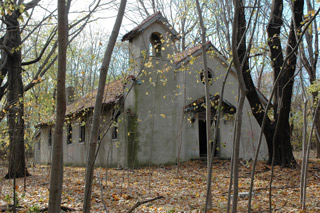|

DATE BUILT: 1909
STYLE: Spanish Colonial Mission
PRINCIPAL ALTERATIONS: Louvers added to bell tower (ca. 1920-1940); shed-roofed addition at rear (probably 1950s)
OTHER DESIGNATIONS: Building 21 (1909-1941); Building 77 (1941-1957)
DESCRIPTION: The Post Chapel was a modest building designed for Christian religious services. It had a capacity of less than 200 worshippers. When dedicated, it was named the Chapel of St. Sebastian, patron saint of archers, gunsmiths and soldiers. It was known to Fort Slocum’s personnel by this name as well as by its less ecclesiastical official Army name.

Like most chapels built on U.S. Army posts before the Second World War, Fort Slocum’s structure was paid for by private funds, and its design did not follow a standardized plan. Its architect is unidentified, but it was built by the firm of Peter Doern, a New Rochelle contractor.
The architectural style of the Post Chapel was not typical of Fort Slocum’s buildings. It was the sole example of Spanish Colonial Mission architecture, and it was one of the few buildings on the post that used stucco walls as part of its original design.
The building was a simple end-gabled structure. It incorporated a low bell tower to the left of the main entrance. The roofs of both the gabled section of the building and the bell tower were clad in red clay tiles. The red tiles handsomely set off the creamy-white sand-finish stucco walls. The shed-roof of the later addition at the rear, however, was clad with common asphalt shingles.
The building had exposed rafter ends, which were cut in a scrollwork pattern, and the porch over the main entrance was supported by heavy brackets. The rows of tall, deep, round-arch windows along the chapel’s two long sides were originally filled with stained glass.
Inside the chapel, the nave and sanctuary essentially comprised a single large rectangular room. The interior was plain. The floor and ceiling were planked in wood; the walls were light-colored stucco.

HISTORICAL NOTES: More than most buildings at Fort Slocum, the Post Chapel embodied the longstanding connections between the Army post and the community of New Rochelle. The chapel was built with funds raised in the community; it was sometimes managed and staffed by members of the community; and it occasionally served the community outside the post.
Rev. Thomas P. McLoughlin played a leading role in building the chapel. Rev. McLoughlin was rector of the Church of the Blessed Sacrament, New Rochelle’s oldest Roman Catholic parish. In 1907 he sought permission to build the chapel from President Theodore Roosevelt, and by 1909 he had raised the funds for its construction.
The Post Chapel was dedicated on November 14, 1909, in ceremonies that included Archbishop John M. Farley, Archbishop of New York. Archbishop Farley, who had recently returned from a visit to Rome, brought papal blessings to the chapel and the assembled soldiers.
Rev. McLoughlin conceived the chapel to fill a deep need at Fort Slocum, since it would offer Catholic soldiers and recruits sacraments and spiritual guidance not readily available from the Army’s predominantly Protestant corps of chaplains. At the same time, however, the chapel also had a mandate to serve non-Catholics.
The extent to which the Post Chapel served these two groups seems to have varied over time. At certain periods, the chapel was used by both Catholics and Protestants, generally by sharing the building for services held at different times, but occasionally through joint rituals and services. At other times, such as during the 1950s, when the Chaplain School provided two Protestant chapels, the Post Chapel was used exclusively for Catholic services.
When Fort Slocum closed in 1965, the Church of the Blessed Sacrament retrieved and distributed the chapel furnishings. The church itself retained three of the chapel’s stained glass windows and distributed five to churches in the Bronx.
|







